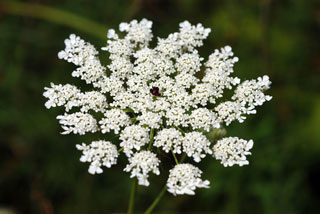QUEEN ANNE'S LACE
|
 |
| File Size: 73 KB |
|
|
|
Daucus carota L.
|
| Cherokee County, Kansas |
| Biennial |
| Height: 16-60 inches |
| Family: Apiaceae - Parsley Family |
| Flowering Period: June, July, August, September |
|
| Also Called: | | Wild carrot. | | Stems: | | Erect, solitary, sometimes branched, hollow, glabrous to bristly or rigid hairy, often reddish or purplish. | | Leaves: | | Alternate, more than once pinnately divided, fern-like, ovate-lanceolate in outline, 2 to 8 inches long, .8 to 2.8 inches wide; ultimate divisions linear to lanceolate, 1/12 to 1/2 inch long, 1/50 to 1/12 wide, margins entire or few-cleft, tips pointed. | | Inflorescences: | | Umbels, compound, 2 to 6 inches broad, terminal and from upper axils, many-flowered, on stalks 3 to 20+ inches long; rays many, unequal, 1.2 to 3 inches long, spreading to loosely ascending at flowering, curving upward and inward at fruiting; secondary umbels with 5 to 20 flowers; involucre bracts pinnately divided, 1/6 to 1.6 inches long, spreading or bent backward in fruit; segments elongate, thread-like. | | Flowers: | | Tiny; sepals absent or minute triangular teeth; petals 5, egg-shaped, white to yellowish-white or occasionally pinkish-white, tip notched; central flower in umbel usually dark purple or rose, sessile. | | Fruits: | | Egg-shaped, 1/8 to 1/6 inch long, brown, ribbed, very bristly; segments 2, each 1-seeded. | | Habitat: | | Open disturbed areas, roadsides, waste areas, pastures, meadows, along railroads, woodland openings, stream banks, and margins of crop fields. | | Distribution: | | Principally east 3/5 of Kansas. | | Origin: | | Native of Eurasia. Imported by early colonists, escaped, and now naturalized. | | Reproduction: | | By seeds | | Toxicity: | | In Europe, it is considered mildly poisonous to horses and cattle. | | Forage Value: | | Unpalatable to livestock. When grazed, it can cause the milk to taste bitter. | | Uses: | | Small mammals and upland game birds eat the seeds. Early settlers were said to have given color to butter with a wild carrot extract. The roots are a source of vitamin A. | | Comments: | | Queen Anne's lace produces a basal rosette of leaves in the first year and a flowering stem in the second year. It is an aggressive invader that can crowd out other vegetation. Related to our cultivated carrot Daucus carota subsp. sativs. |
|
| Queen Anne's lace |  | | 74 KB | | Cherokee County, Kansas |
| | Queen Anne's lace inflorescence at fruiting and bracts |  | | 39 KB | | Cherokee County, Kansas |
| | Queen Anne's lace inflorescence |  | | 55 KB | | Cherokee County, Kansas |
| | Queen Anne's lace |  | | 103 KB | | Woodson County, Kansas |
| | Queen Anne's lace flowers |  | | 93 KB | | Woodson County, Kansas |
| | Queen Anne's lace |  | | 120 KB | | Woodson County, Kansas |
| | Queen Anne's lace leaf |  | | 77 KB | | Woodson County, Kansas |
| | Queen Anne's lace |  | | 140 KB | | Woodson County, Kansas |
| | Queen Anne's lace inflorescence |  | | 91 KB | | Woodson County, Kansas |
| | Queen Anne's lace leaves |  | | 96 KB | | Woodson County, Kansas |
| | Queen Anne's lace habit |  | | 135 KB | | Wildcat Glades, Newton County, Missouri |
| | Queen Anne's lace inflorescence |  | | 73 KB | | Wildcat Glades, Newton County, Missouri |
| | Queen Anne's lace inflorescence |  | | 101 KB | | Wildcat Glades, Newton County, Missouri |
| | |
|
|
|
|
|
|















